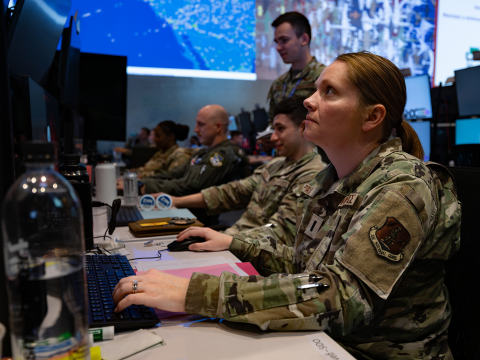STEM Is a 21st Century Critical Element of National Security
October 4, 1957, is when the world of technology changed for the United States. President Dwight D. Eisenhower awoke to discover the Soviet Union had surged in science and technology by launching Sputnik—the first artificial satellite to orbit the earth. Overnight, the communist giant had become a scientific juggernaut in the eyes of the world. A month later, during National Education Week on November 11, President Eisenhower announced in a nationwide address that the future of national security for America would depend on the need for thousands of scientists in the next 10 years.
In the 1990s, the National Science Foundation would combine science, technology, engineering and mathematics into the acronym STEM—composed of these four separate fields that interrelate despite being specific disciplines. The information technology heroes of today and those advancing to the front are rooted in STEM.
President Barack Obama in 2009 launched his “Educate to Innovate” policy with a $260 million funding package focused on encouraging STEM education. Six years later, the national budget for 2015 allocates $2.9 billion for STEM education.
John Holdren, assistant to the president for science and technology, wrote in a December 2011 report, “High-quality STEM education is critical for the prosperity and security of our nation.” His observation remains as relevant today as did Eisenhower’s in 1957.
Dennis Vilorio, Bureau of Labor Statistics (BLS) economist, forecasts a requirement for 9 million new STEM graduates by 2022. And future STEM requirements for the ever-expanding medical field are not included in this total.
Companies such as AT&T, Lockheed Martin, CACI, Intel, Microsoft, Motorola, Booz Allen Hamilton and hundreds of others actively are supporting STEM education. As early as 2011, industry was referring to a STEM crisis because corporate America recognized how critical STEM was to business survival.
The Navy’s Fleet Cyber Command/Tenth Fleet (FCC/C10F) is a heavy hitter in recognizing the need for STEM professionals. FCC/C10F is responsible for operating and defending the Navy’s networks, communications and space assets and conducting full spectrum cyber operations. Vice Adm. Jan Tighe, USN, the commander of FCC/C10F, says, “The demand for skilled Cyber and SIGINT [signals intelligence] professionals in our mission continues to grow, as the world becomes more dangerous and information technologies more complex. We are intent on building a workforce with a solid foundation in STEM education coupled with keen analytic capability and ingenuity to ensure that they can be most successful in the evolving electromagnetic spectrum and cyberspace domains in which we operate.”
If any government agency can say it is a functioning STEM organization, it is the Defense Information Systems Agency (DISA). DISA is active from the high school level to colleges and universities across the nation. It is a technology behemoth created by its primary mission as the command, control, communications, computing, intelligence, surveillance, and reconnaissance (C4ISR) agency for the warfighting forces of the United States. DISA has numerous avenues for identifying and bringing to the agency information technology experts, whether through college scholarships, internships or hiring proven information technology professionals.
The DISA Information Assurance Scholarship Program (IASP) is one such avenue. Philip Lagarde is an IASP recipient who graduated from Mississippi State University with a computer science degree. Lagarde says, “After completing my semester as an intern I began work at DISA as a computer scientist putting my coursework to the task. I’m on a team filled with computing superstars as we do everything we can to improve and protect the Defense Department network.”
DISA works to place new hires into an information technology field that complements their STEM education. Experienced professionals are assigned as mentors for the new hires in transitioning to a fast-paced technical environment.
Eli Konikoff is a technical director within the Mission Assurance department and also Lagarde’s mentor. "Philip Lagarde joined our team as a young intern as part of the DISA STEM recruitment program. I encouraged Philip to share his thoughts about what we were doing. In just a short time, I noticed he was displaying the initiative and forward thinking that I hoped he would. He showed great interest in our software defined network piloting efforts, and when he brought forth ideas on how to improve the program, we listened. Philip's initiative and innovative drive for process improvement is an attribute that grew from his STEM education. I like to think that our STEM recruitment program is helping us build the solid cadre of civil servants needed to keep our nation safe for the next generation."
The Information Age has created a global digital enterprise of such complexity of things that STEM has become a 21st century critical element of national security.
David E. Meadows, MBA, MS, is the author of The Sixth Fleet.




Comment
very good.
very good.
Comments